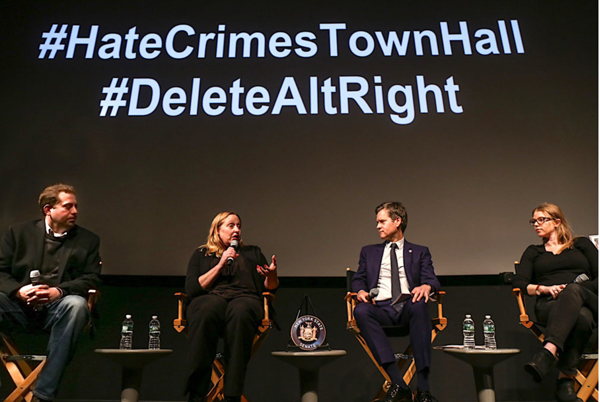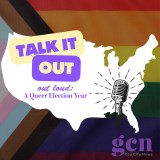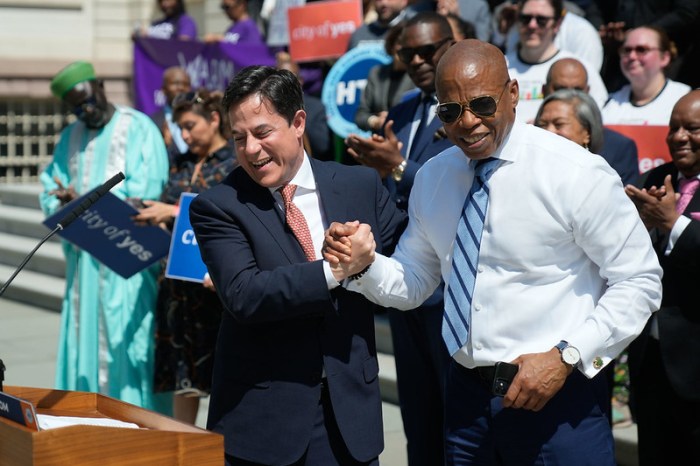
BY LINCOLN ANDERSON | With hate frighteningly in the air these days, the word was emblazoned in blue on the marquee of Chelsea’s SVA Theatre on January 29. So was Brad Hoylman’s name — because the state senator, himself the victim of recent hate-motivated harassment, is trying to help people find answers to what is fueling the craziness currently gripping the country.
More than 300 people turned out for a screening of a documentary looking at the roots of hate crimes, followed by a panel discussion about the “alt-right” at an event Hoylman hosted.
Rebecca Teitel, the producer and director of the film, “Hate in America: Stories From the Files of the Southern Poverty Law Center,” was on the panel, along with Oren Segal, director of the Center on Extremism at the Anti-Defamation League (ADL), and Heidi Beirich, director of the Intelligence Project at the Southern Poverty Law Center (SPLC).
Meanwhile, the name on everyone’s mind was Steve Bannon, the former editor of Breitbart News — a news outlet he himself dubbed “the platform for the alt-right.” That weekend, President Donald Trump had elevated Bannon to the National Security Council, an unprecedented appointment of a political advisor to a sensitive policy post.
A headline about that shocking development was flashed on the movie screen behind Hoylman as he gave his opening remarks.
“Make no mistake about it,” the West Side state senator said, “a white nationalist with an apocalyptic world vision will be at the table for every national security decision.”
Trump’s imposition of a ban on refugees and immigrants from seven Muslim-majority nations several days earlier compounded the anxiety felt by many in the room.
Hoylman noted how he had been targeted by haters in the wake of Trump’s election. After he went public with the fact that swastikas had been found carved into a service-elevator door in his Village apartment building, Hoylman found himself bombarded with vicious tweets from alt-righters, he said.
New York Police Department statistics showed a 23 percent increase in reported hate crimes throughout the five boroughs in 2016, Hoylman added.
The film follows veteran journalist Tony Harris as he conducts interviews to try to uncover the root causes of several recent heinous hate crimes, ranging from Mississippi to Midtown Manhattan. These include the killing of James Craig Anderson, a 49-year-old gay African-American man, by a group of young whites in Jackson, Mississippi, in 2011. The youths singled him out, beat him up, and then intentionally ran him over with their truck.
The Southern Poverty Law Center has been tracking hate crimes since 1971, and, according to its data, the LGBTQ community is the group most often targeted for such crimes. However, in Anderson’s case, it wasn’t clear that he was singled out for his sexuality. He had been slightly inebriated and his white attackers, who had been drinking earlier at a party, were cruising for a black victim.
The film also documents the 2012 massacre at the Sikh Temple of Wisconsin near Milwaukee, in which white nationalist Wade Michael Page killed six people and wounded four before fatally shooting himself. The film notes that Page had recently lost both his job and girlfriend, the types of setbacks that are often triggers for hate violence. Harris interviews a founder of the white nationalist group Page belonged to, who has since renounced racism and hate. What changed him, the man explained, was that since having a daughter he’s had something more constructive and meaningful to put his energies into.
The third incident in the film was closer to home. On May 5, 2013, Nicholas Porto and a friend were walking near Madison Square Garden around 5 p.m. when they were verbally harassed by eight or nine Knicks fans who started calling them “fags.”
When one of the men mocked Porto’s jeans, he responded, “I made them” — after which he promptly found himself thrown to the gutter and punched and kicked in a rapid and brutal beatdown. After Porto spoke out about the incident, he, too, received hate mail. He said he also suffered post-traumatic stress disorder.
Shortly afterward, Mark Carson, a young gay man, was shot to death on West Eighth Street in the Village by a man who had been shouting homophobic insults at him.
Hoylman is shown in the film noting that there were nine hate-crime incidents in his district that summer, which some called “The Summer of Hate.”
After the film, Public Advocate Letitia James spoke, noting she had been at JFK Airport the day before, where she stood in solidarity with a female Muslim airport worker who had been harassed by a passenger who told the worker, “Trump is here now,” before kicking her.
“Prejudice and vitriol goes to the top of power now,” James said. “The word has power and consequences, and so do presidential actions. But I tell you, this will not be normalized.” At that, the audience applauded.
Teitel began her remarks by noting that, in light of Trump’s election, “the ending no longer seems pertinent,” in its assessment of the problem’s scope.
SPLC’s Beirich said that what white nationalist Page and his group wanted to do was “turn back the tide of multiculturalism in the United States. We have an administration that wants to turn the tide back to a lot of what we saw in the film.”
ADL’s Segal, however, stressed, “I think it’s important to focus on the Trump administration in terms of what they do, not what they say. We focus on what they do because that’s going to give us an ability to respond.”
He also emphasized that not all Trump supporters are members of the alt-right. As to the alt-right itself, Segal said, “Yes, anti-Semitism is at the heart of the alt-right,” but added, “What extremist movement isn’t anti-Semitic?”
According to a report by the ADL, anti-Semitic speech online spiked dramatically during the 2016 presidential campaign. From August 2015 through July 2016, Segal said, there were 2.6 million tweets found to contain language consistent with anti-Semitic speech. Journalists were bombarded by a total of 19,253 anti-Semitic tweets, but 63 percent of these tweets targeted just 10 members of the media.
“One of them told us she was going to buy a gun to protect herself,” Segal noted, adding the journalist was even thinking of leaving the profession.
Beirich explained that part of her job is to read Breitbart News.
“It actually has a section on black-on-white crime,” she noted.
Bannon, she said, is the “main offender” in the administration right now.
“Trump is welcoming some of the worst elements of our society,” Beirich said. “This is the opposite of the Civil Rights Movement. The country has been working for decades to get rid of this.”
She called Milo Yiannopoulos — a young gay tech editor at Breitbart whose scheduled appearance at the University of California at Berkeley several days later would lead to a violent confrontation with protesters and its cancellation — “the gateway drug.”
“He tries to create the idea that he’s just kidding,” she said.
“He now has a book deal,” Hoylman interjected, drawing groans from the audience.
Segal explained that most US extremists are “unaffiliated” with specific groups.
“People go online and pull a lot of what they connect with,” he said. “Most people will find hate on their phones walking down the street.”
Added Beirich, “Dylann Roof can go online and never even meet these people,” referring to the Charleston church mass murderer who killed nine people.
Nevertheless, hate groups are on the rise. According to the SPL, there were 602 of them in the U.S. in 2000. Today there are around 1,000.
“There’s no doubt it’s a backlash to demographic change” Beirich said. “These people do not like the direction of the country, which is away from whiteness.”
Added Segal, “I have never seen so many hate messages reference a presidential campaign.”
“I was trolled after the swastika was found in my building,” Hoylman noted. “It said, ‘Hey Rabbi, what ya doin’?’”
Was that some sort of code word?, he wondered. Segal noted that online trolls’ current code for Jews is “skypes,” which is how they avoid automatic filters.
“It will probably change by next week,” he shrugged.
Asked by a woman in the audience about the alt-right’s hatred of Jews, Segal said that white supremacists think Jews are “not white… and are responsible for race mixing.”
“Well, that would make me proud, as a Jew,” the woman responded.
Teitel warned that with the new Trump administration, “It’s really unlikely you’re going to get the Department of Justice investigating hate crimes.”
Hoylman asked if the current climate would likely make more people become racist. Sadly, the answer from the panelists suggested the answer is yes.
“It was about Mexicans the first day, then Muslims,” Beirich said. “It normalizes it. The Civil Rights Movement was about de-normalizing it.”
As the event ended, Hoylman said, “Everybody in the country needs to take stock of what they can do to push back on this attack on our pluralistic society.”

































